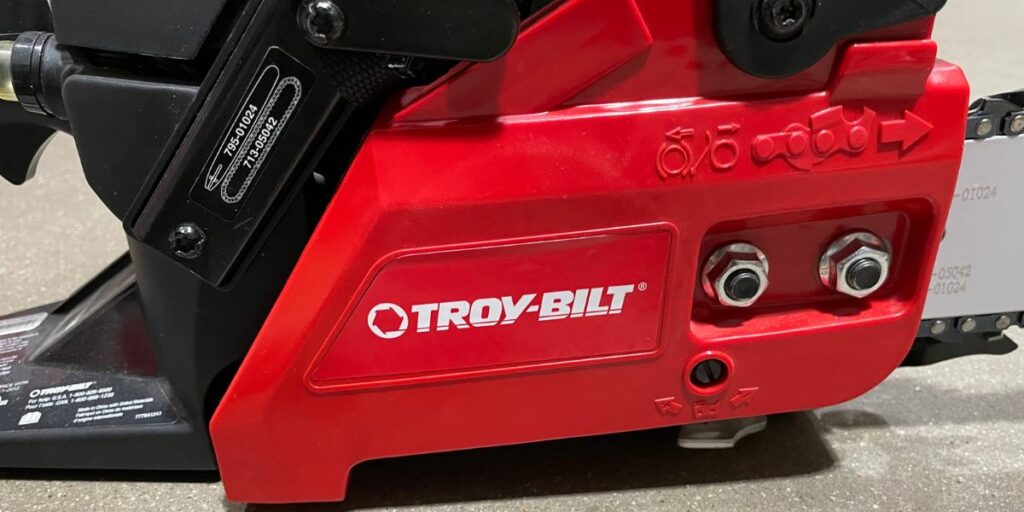FIX: The Chain Won’t Turn or Move on a Troy-Bilt Chainsaw
The chain’s rotation can be impacted by a number of factors, not the least of which is a broken guide bar. If you can locate the issue and rectify it, you may resume sawing in a risk-free manner.
If the chain of your Troy-Bilt chainsaw stops turning while the brake is applied, it might be because the bar and chain aren’t properly greased, the chain tension is too high, or the clutch pads are worn.
Before examining the chain, make sure the chainsaw is turned off and all of the moving parts have stopped. To avoid slicing your hands when working with the chain, we recommend that you put on some gloves.

Before diagnosing, repairing, or operating the equipment, be sure you’ve read and understood all of the safety recommendations in the operator’s handbook. If you don’t feel confident in your ability to conduct the repair safely due to a lack of experience, training, or health, it’s best to call in an expert.
Table of Contents
Possible Causes of a Stuck or Unable-to-Move Troy-Bilt Chain
Troy-Bilt Chainsaw with Activated Chain Brake
For added protection, your Troy-Bilt chainsaw features a guard just forward of the handle. The guard here acts as a brake on the chain.
If the chainsaw kicks back at the operator, the chain brake will engage to prevent injury. The chain brake prevents the blade from moving, minimizing the risk of harm.
A manual forward push on the chain brake can also halt the chain. When the chainsaw is not in use or being transported, this should be done.
Pulling the guard to the back of the saw will release the chain brake and free the chain for movement, which may be checked to make sure the brake isn’t on.
Broken Troy-Bilt Chainsaw Due to Dry Bar and Chain
Keep the bar and chain well-oiled, or else friction and heat will rise. Without adequate lubrication, the chain will start to travel very slowly.
Start your chainsaw at about three-quarters throttle and hold the bar about a foot off the ground to see whether oil is dripping down onto the chain. After a few minutes of using the saw, you should see a line of oil on the floor.
Unless oil is visible, the part is not being properly oiled. See if the bar still has its luster by inspecting it. Fix the broken or worn out guide bar. The oil channel should next be inspected, and if necessary, cleaned.
Automatic oilers on Troy-Bilt chainsaws have an adjustable screw. The oil flow may be adjusted by rotating the screw either clockwise or counterclockwise.
Keep the bar and chain on your Troy-Bilt well-oiled at all times. Always remember to add more bar and chain oil when you refuel your vehicle.
Keep in mind that if your oil level becomes too low, you might not have enough time to replace the gasoline tank before your chain oil runs out.
Adjust the Bar and Chain Oil Temperature for Best Performance
- Oil that thickens and becomes tacky at cold temperatures has to be diluted. There is a winter-specific chainsaw oil available from Troy-Bilt.
- The normal temperature-appropriate weight:
Chain Tension on Troy-Bilt Too Strict
Since the chain will stretch with usage, it needs to be lengthened periodically. If the chain is too snug around the bar, it will be unable to spin.
Tighten the chain on a Troy-Bilt chainsaw by following these steps:
- Pull the wire from the spark plug.
- Release the chain’s tension.
- Unscrew the nuts that secure the bar that sits atop the clutch and chain brake.
- Raise the bar’s front end so that the nose is pointing upward.
- To relax the chain, turn the tensioning screw counterclockwise, and to tighten it, turn it in the opposite direction.
- After you’ve got the right amount of tension, keep the bar’s nose up while you tighten the retaining nuts.
The chain has to be snug around the bar without restricting its motion. It’s important that the chains aren’t so slack that it dangles from the guide bar.
Problems with a Troy-Bilt Chainsaw Caused by Worn Clutch Pads
Over time, the clutch pads may become worn. This prevents the clutch drum from turning the chain. Any Troy-Bilt chainsaw will require a new clutch component.
Causes of a Troy-Bilt Chainsaw’s Slow Chain Speed
A Troy-Bilt Chainsaw’s Carburetor Requires Fine-Tuning
Your carburetor will include a screw to control the idle speed. The fuel-to-air ratio may be changed using this screw.
First, spin the screw counter-clockwise until the chain stops moving while the chainsaw is idling.
Troy-Bilt Chainsaw with Exhausted Clutch Springs
The clutch shoes on a Troy-Bilt chainsaw are automatically retracted by springs in the centrifugal clutch.
The shoes make contact with the drum as a result of centrifugal force generated by the rotating engine. The chain moves along the bar as the drum rotates.
The clutch shoes should stop the chain from moving as the engine revs down, thanks to the action of the spring. The worn springs in your Troy-Bilt chainsaw might be the cause of your chain’s continued movement.
Read More: Troy-Bilt Chainsaw






